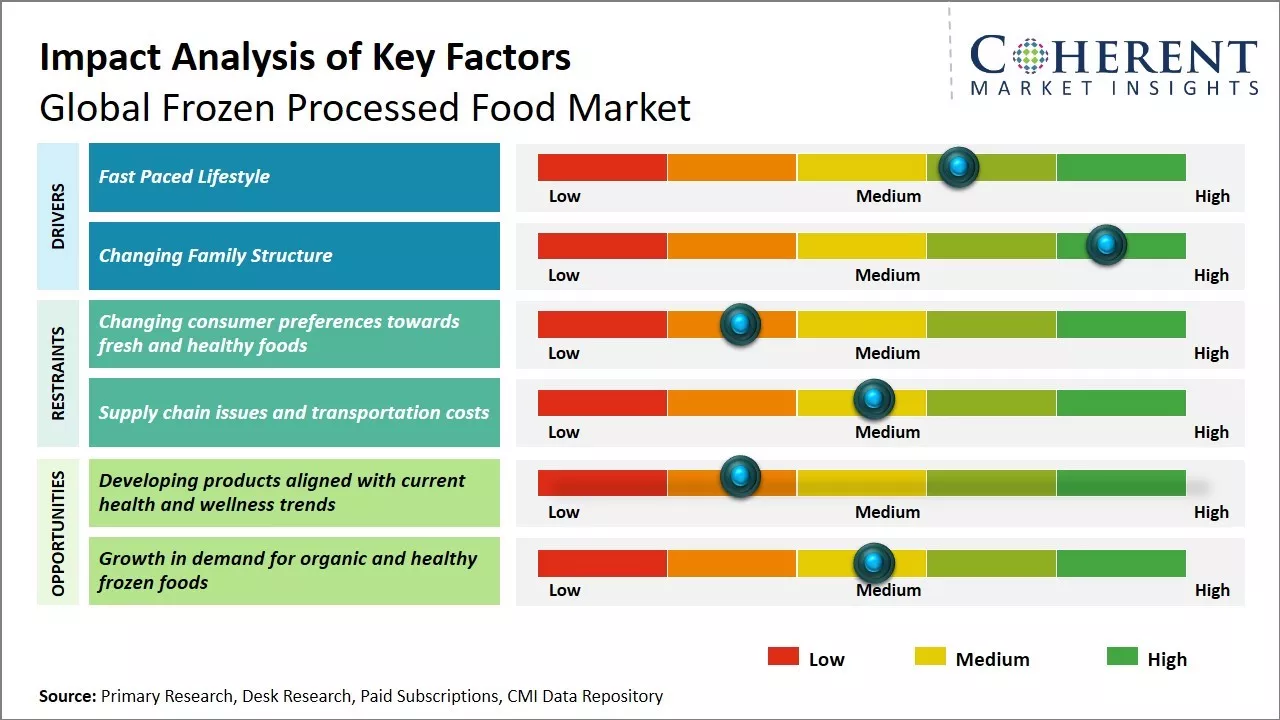Global frozen processed food market is estimated to be valued at USD 77.33 Bn in 2025 and is expected to reach USD 95.17 Bn by 2032, exhibiting a compound annual growth rate (CAGR) of 3.0% from 2025 to 2032.

To learn more about this report, Download Free Sample
The frozen processed food market is growing due to rising demand for convenient, ready meals amid busy lifestyles and increased health awareness favoring nutritious options like frozen vegetables. Technological advancements in freezing methods enhance product quality, while expanding e-commerce platforms boost accessibility. For example, in France, frozen French fries sales surged by 25%, driven by younger consumers preferring quick, hassle-free food. This shift has prompted significant investments in processing infrastructure, highlighting how consumer convenience and evolving eating habits are key growth drivers in the frozen processed food market.
|
Event |
Description and Impact |
|
Global Supply Chain Disruptions and Geopolitical Tensions |
|
|
Energy Crisis and Cold Chain Infrastructure Challenges |
|
|
Climate Change and Agricultural Disruption |
|
Uncover macros and micros vetted on 75+ parameters: Get instant access to report
Consumer behavior in the frozen processed food market is increasingly shifting towards organic and natural food options, driven by heightened health awareness and demand for transparency. Innovation in frozen processed food, such as clean label frozen processed food formulations free from artificial additives and preservatives, are gaining traction as consumers seek products with improved nutritional content in frozen processed foods. This trend aligns with the growing preference for sustainably produced foods, emphasizing sustainability in frozen processed food production to reduce environmental impact.
Despite advances, frozen processed food logistics challenges and frozen processed food supply chain insights continue to impact the availability and freshness of organic products. However, improved cold chain technologies and supply chain insights are enabling better preservation of quality and nutrients, encouraging higher frozen processed food consumption statistics in organic segments.
The rising demand for clean label frozen processed food reflects a broader shift toward trust and authenticity, making it a critical growth driver. Market players focusing on transparent sourcing, sustainable packaging, and innovative formulations are well-positioned to capture this expanding consumer base seeking both convenience and wellness in frozen processed foods.
For 2023, the global frozen processed food market is worth $291.8 billion and has a varied pricing structure by product class, geography, and brand stratification. Pricing is typically categorized into three tiers: premium, mid-tier and value. Premium frozen meals, Amy’s Organic and Häagen-Dazs ice cream brands’ priced from $4.99 to $7.99 per entrée and $5.99-$7.99 per pint respectively. Stouffer’s Classic meals and DiGiorno’s frozen pizzas, priced at $3.49-$4.99 and $4.99-$7.99 respectively, mark the mid-tier segment.
Also, frozen vegetables from Birds Eye and Green Giant are priced between $1.99 and $4.49 per bag. Budget priced meals are situated at the value tier, with brands like Great Value and Banquet priced below $3. North America leads regionally with the US priced at $4.99-$8.99 for premium frozen meals, Canada priced slightly higher. European markets such as the U.K., Germany, and France show comparable mid to premium pricing with frozen vegetables priced between €1.49 and £3.49 per bag.

To learn more about this report, Download Free Sample
The fast-paced lifestyle of people globally has significantly contributed to the rise of the frozen processed food market in recent years. With people's schedules getting busier due to long working hours, heavy traffic commute and other daily activities, they have little time left for cooking meals from scratch on a daily basis.
Frozen processed foods provide a convenient solution as they can be stored for long durations and prepared quickly with little effort. These foods only require reheating in microwave or oven before serving. This trend is particularly prominent among working professionals residing in urban areas.
According to UN department of Economic and Social Affairs, over 68% of the world's population is projected to live in urban areas by 2050. Cities provide greater employment opportunities but also come with challenges of higher living costs and stressful lifestyles. Busy urban dwellers find frozen meals to be a practical option that saves them considerable time spent on grocery shopping and cooking, allowing them to relax after a long day at work.
Even families and individuals in rural areas have started embracing frozen foods as they offer variety and nutrition without much effort. The fast nature of today's world will continue driving the demand for convenient, ready-to-eat options in the foreseeable future. Younger generations who are entering the workforce in large numbers have grown up in a digital era and want quick solutions.
Furthermore, women joining the workforce in developing nations is increasing household income but reducing cooking time. According to statistics by International Labour Organization, the percentage of women employed in developing countries increased from 35% in 1990 to 39% in 2019. This evolving demography prefers frozen meals as they provide better time management.
The structure of families has undergone massive changes over the past few decades. Dual income households are now the norm rather than the exception. Many families also have single parents who juggle child rearing duties alone. Elderly people are also preferring to live independently for longer. All these changes have significantly reduced the time availability at home to plan and prepare meals.
Frozen processed foods help service the nutritional needs of such diverse family models. For example, a working mother can pop a frozen pizza in the oven rather than slaving over a hot stove after a long day. Senior citizens find ready meals healthier than eating out and easier on their budgets than cooking for one. Busy families now have safe, nutritious and hassle-free food options without compromising on taste or quality due to the growth of the frozen processed food industry.
Global frozen processed food market faces challenges from changing consumer preferences towards fresh and healthy foods. Rising health concerns associated with high sugar, salt, fat content of frozen meals boosts demand for better-for-you frozen options.
Despite challenges, the frozen processed food market holds potential for growth by developing products aligned with current health and wellness trends. Offering frozen meals and snacks with clean label ingredients, more nutritional value, and diverse global flavors presents an opportunity to attract newer customers. With rising demands for convenience, there is also scope for frozen ready meals and appetizers that offer time-saving preparation at affordable price points.
Frozen processed poultry segment is estimated to contribute the 37.2% share of the global frozen processed food market in 2025, owing to convenience and affordability. As more people lead busy lives with less time to cook from scratch every night, frozen poultry products offer a solution.
Boneless, skinless chicken breasts, turkey burgers, or chicken nuggets all can be prepared in under 30 minutes with little effort. The convenience of popping frozen poultry in the oven or microwave makes it an attractive weekday dinner option for families and individuals alike. Affordability is another key reason for frozen poultry's popularity.
While fresh chicken and turkey can be pricey, frozen versions provide the same proteins at a more budget-friendly cost. This allows consumers to stretch their food dollar further and spend less to feed their households nutritious meat. As inflation puts pressure on consumer budgets globally,
Frozen poultry acts as an affordable alternative to pricier fresh or deli counter meats. Advancements in freezing and packaging technologies have also boosted frozen poultry's quality and shelf life in recent years. Products now stay fresher for longer in home freezers. Added marinades, breading, and sauces further enhance flavor and moisture.
Supermarkets/ Hypermarkets segment is estimated to contribute the 38.2% share of the global frozen processed food market due to their ability to offer consumers a wide assortment under one roof. Most frozen food shoppers appreciate getting all or most of their grocery needs met in a single trip. Supermarkets satisfy this preference with expansive stores housing everything from produce to packaged goods to meat and dairy. Within their frozen aisles, supermarket giants devote significant space to frozen processed items like meals, snacks, bakery products and more.
Shoppers benefit from a one-stop assortment of familiar brands alongside private label and niche options. Whether stocking up for the week or browsing for a special meal, people can find inspiration without needing multiple locations. As consumer diets diversify, supermarkets adjust freezers accordingly to represent global flavors.
Pricing also plays a role in supermarket dominance. As high-volume outlets, these leverage scale to offer competitive frozen food prices. With the greatest level of selection, value and convenience, supermarkets make themselves the obvious destination for regular frozen food stock-ups. Their massive frozen footprints cement their position as leaders in the distribution of this growing market.

To learn more about this report, Download Free Sample
North America has established itself as the dominant region in the global frozen processed food market with estimated 41.6% share in 2025. With a highly developed food processing industry and presence of major manufacturers, the U.S. and Canada account for the bulk of frozen processed food consumption in the region. The meal solutions and snacks segments within the frozen food category have seen strong growth over the last decade.
Companies have utilized innovative packaging and launched single-serve frozen meals to cater to the busy lifestyles and eat-on-the-go culture in North America. Another key factor for North America's prominence has been aggressive marketing campaigns.
Manufacturers promote their products through sports and cultural sponsorships, which have helped freeze foods gain further mainstream acceptance. International trade has also been a major growth lever. While North America maintains a trade surplus in frozen food, imports from other developed markets supplement local supply. This allows consumers access to a wide variety of cuisines without compromising on quality and pricing.
Among developing markets, Asia Pacific has emerged as the fastest growing region for frozen processed foods. Rapid urbanization and rising income levels in populous nations such as India and Indonesia is driving changes in dietary patterns and food consumption habits. While fresh foods remain predominant, time-pressed lifestyles are pushing consumers to explore convenient frozen alternatives. This helps local brands establish market presence internationally as well.
Changing demographics with a growing working women population also make Asia an attractive promising region. Companies are responding by tailoring products to regional tastes, launching smaller affordable packs and educating consumers about product benefits like minimal food loss. The combination of favorable demand and supply dynamics have made Asia Pacific the force to watch out for in the global frozen food landscape.
| Report Coverage | Details | ||
|---|---|---|---|
| Base Year: | 2024 | Market Size in 2025: | USD 77.33 Bn |
| Historical Data for: | 2020 To 2024 | Forecast Period: | 2025 To 2032 |
| Forecast Period 2025 to 2032 CAGR: | 3.0% | 2032 Value Projection: | USD 95.17 Bn |
| Geographies covered: |
|
||
| Segments covered: |
|
||
| Companies covered: |
Unilever , Nestle , Conagra Brands, Inc., GRUPO BIMBO , General Mills Inc., Kellogg Co. , McCain Foods Limited , The Kraft Heinz Company , Associated British Foods plc, Ajinomoto Co. Inc., Vandemoortele , Lantmannen Unibake , Cargill, Incorporated , Europastry , JBS Foods , Kidfresh , Aryzta.com , Shishi He Deming Seafood Co Ltd, OOB Organic , Omar International Pvt Ltd. |
||
| Growth Drivers: |
|
||
| Restraints & Challenges: |
|
||
Uncover macros and micros vetted on 75+ parameters: Get instant access to report
*Definition: Global Frozen Processed Food Market refers to the market for frozen food products that have been processed or prepared for consumption at a later time. This includes foods like frozen pizza, frozen ready meals, frozen meat and poultry products, frozen seafood products, frozen bakery products, and frozen fruits and vegetables.
Share
Share
Missing comfort of reading report in your local language? Find your preferred language :
Transform your Strategy with Exclusive Trending Reports :
Frequently Asked Questions
Joining thousands of companies around the world committed to making the Excellent Business Solutions.
View All Our Clients